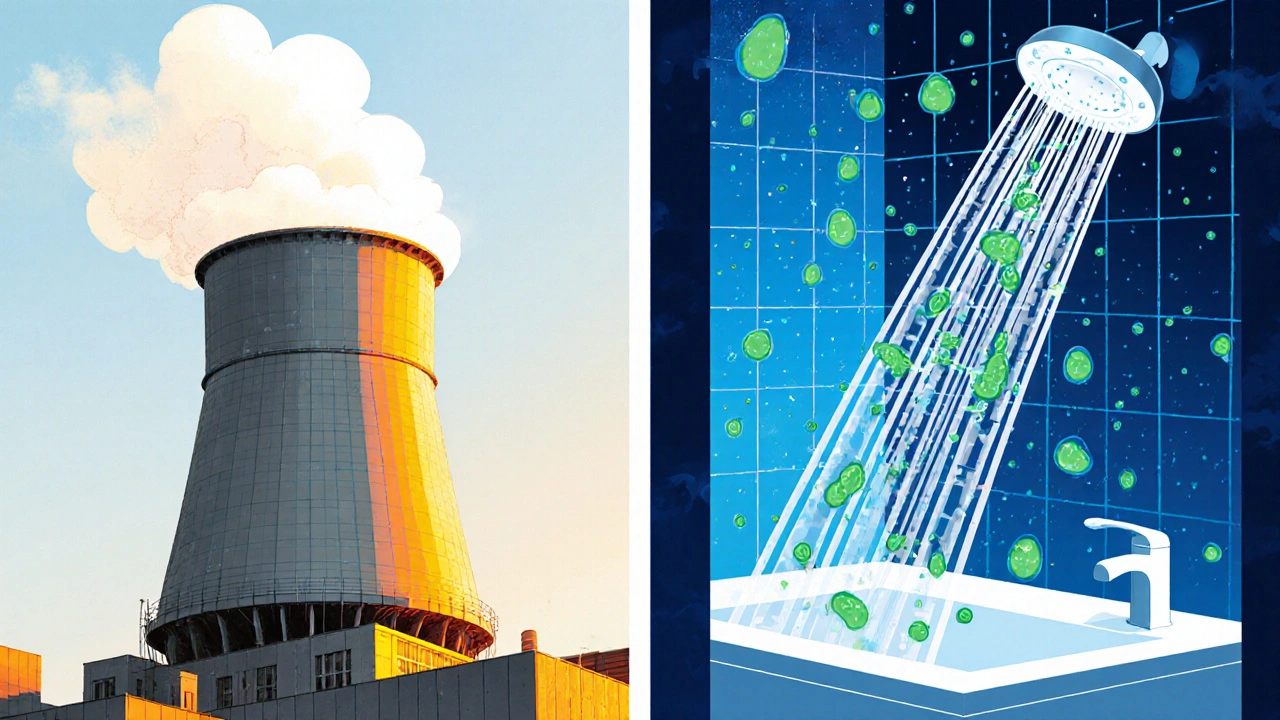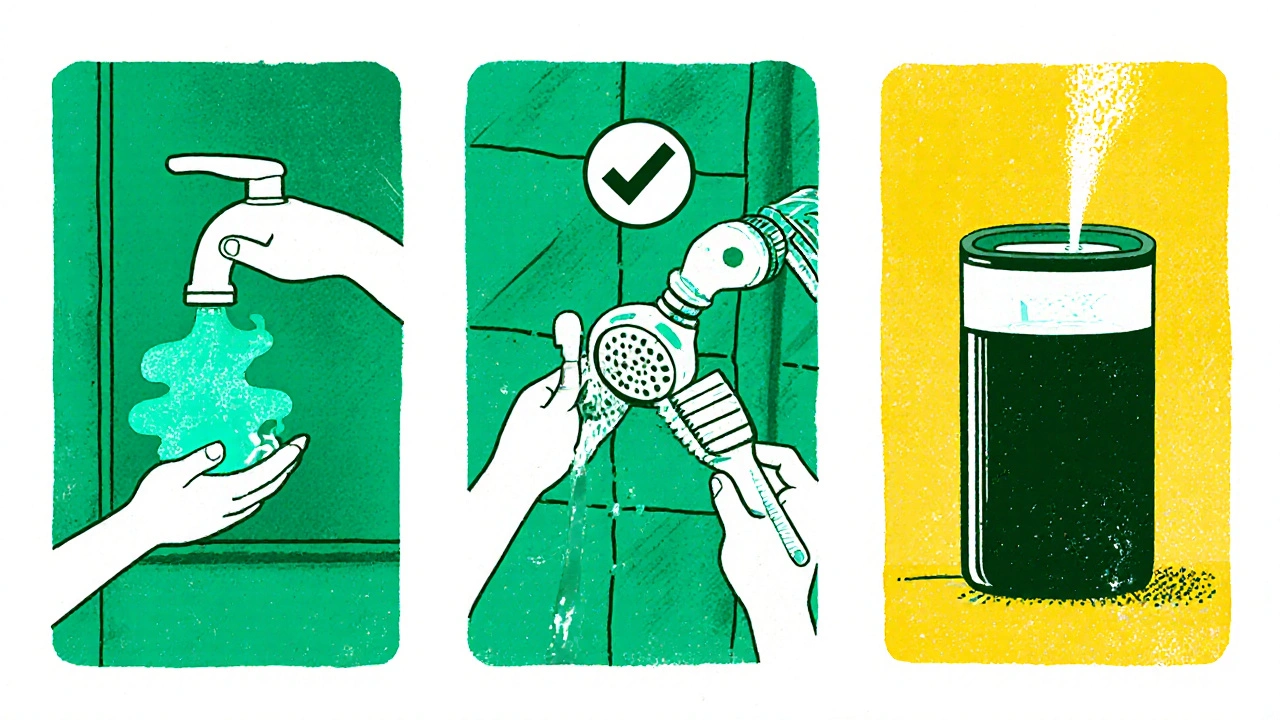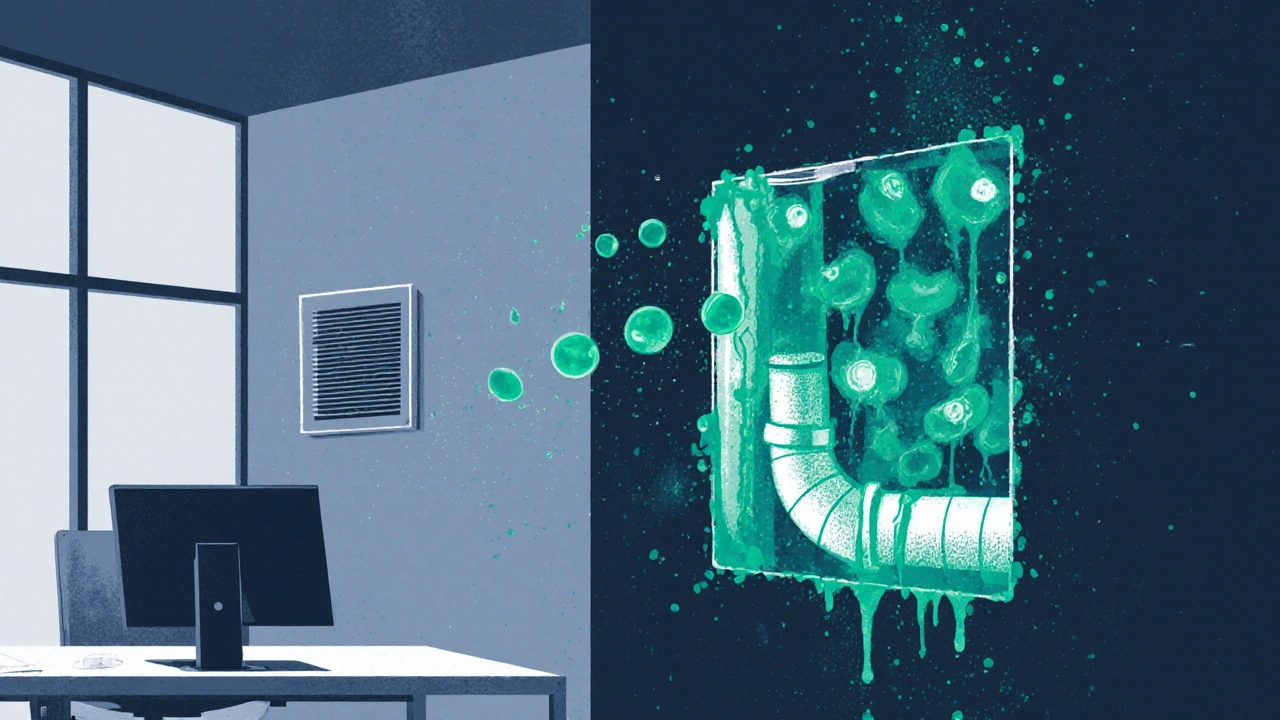Legionella Risk Assessment Tool
Assess Your Water System Risk
This tool calculates the risk of Legionella bacteria growth based on your water system conditions. Legionella thrives between 20°C and 45°C.
Ever wondered why a perfectly ordinary office building or a cozy home can sometimes become a health hazard? The link between Legionnaire's disease and the air we breathe indoors is more than a coincidence. Poor indoor air quality can turn harmless water systems into breeding grounds for the Legionella bacteria, putting occupants at risk of a serious pneumonia‑like illness. This guide breaks down how the disease spreads, what indoor environments contribute to it, and what you can do right now to keep the air safe.
What Is Legionnaire's Disease?
Legionnaires' disease is a severe form of pneumonia caused by inhaling water droplets contaminated with Legionella bacteria. First identified after a 1976 outbreak at an American convention, the disease now accounts for about 2-5% of all pneumonia cases in many countries. Symptoms usually appear 2 to 10 days after exposure and include high fever, chills, cough, muscle aches, and sometimes gastrointestinal upset.
Indoor Air Quality: The Silent Partner
When you think of indoor air quality, dust and allergens often come to mind. But the air we breathe also carries microscopic water particles, especially in buildings with complex water systems. If those systems harbor Legionella, the bacteria can become aerosolised-tiny droplets that travel through vents, showers, or even cooling tower sprays. Once inhaled, they can lodge deep in the lungs and trigger infection.
How Legionella Takes Up Residence Indoors
Legionella thrives in warm, stagnant water (20‑45 °C). That temperature range is common in many building components:
- Cooling towers large water‑filled structures that regulate building temperature
- HVAC systems heating, ventilation, and air‑conditioning units that circulate air and water
- Hot‑water tanks, decorative fountains, and spa‑like whirlpools
When water sits unused or flows too slowly, biofilm-a slimy layer of microbes-forms on pipe walls, providing a protective niche for Legionella. Routine flushing or temperature control can disrupt this growth, but many facilities overlook these simple steps.

From Water to Air: The Aerosol Transmission Path
Legionella doesn’t spread through direct contact or ordinary air. It needs to hitch a ride on aerosolised water droplets. This process, called Aerosol transmission the conversion of liquid particles into a fine mist that can be inhaled, occurs when:
- Water is forced through a nozzle (e.g., showerheads, faucets)
- Cool‑mist humidifiers release a fine spray
- Cooling‑tower fans disperse water droplets into the surrounding air
Anyone breathing these droplets within a few meters can inhale the bacteria, making indoor air quality a direct conduit for infection.
Spotting the Symptoms and Getting a Diagnosis
Because Legionnaires' disease mimics other types of pneumonia, it often goes unnoticed until lab tests confirm it. Key signs to watch for include:
- Sudden high fever (often > 39 °C)
- Severe cough, sometimes producing sputum
- Shortness of breath and chest pain
- Headache, confusion, or muscle aches
If you suspect exposure-especially after staying in a hotel, hospital, or office building with known water‑system issues-ask your doctor for a Legionella urine antigen test or a sputum culture. Early diagnosis dramatically improves recovery odds.
Preventing Legionella Through Better Indoor Air Quality
Stopping Legionella at the source is the most effective strategy. Below is a concise checklist for building owners, facility managers, and even savvy homeowners:
| Risk Factor | Mitigation Strategy |
|---|---|
| Stagnant water in pipes | Implement regular flushing schedules (at least weekly for low‑use outlets) |
| Temperatures between 20‑45 °C | Maintain hot‑water storage above 60 °C and cold water below 20 °C |
| Unclean cooling towers | Follow EPA guidelines the U.S. Environmental Protection Agency's recommendations for cooling‑tower maintenance for weekly cleaning and biocide treatment |
| Faulty humidifiers | Use distilled water and replace filters monthly |
| Biofilm buildup | Apply approved disinfectants (e.g., chlorine, monochloramine) and monitor residual levels |
Beyond mechanical steps, good indoor air quality also means proper ventilation. Aim for at least 5‑10 air changes per hour in high‑risk areas and install HEPA filters where aerosols may be generated.

Case Study: A Hospital Outbreak Fixed With Simple Controls
In 2023, a regional hospital in Queensland reported ten confirmed Legionnaires' cases within two weeks. An inspection revealed a cooling‑tower that hadn’t been cleaned in over a year. After the facility instituted weekly cleaning, raised water temperatures, and added UV sterilisation, no new cases appeared. The incident underscores how a few targeted actions can dramatically improve indoor air safety.
Quick Checklist for Homeowners
- Run hot water (≥ 60 °C) for at least 3 minutes on seldom‑used taps weekly.
- Clean bathroom showerheads and faucet aerators every 6 months.
- Use distilled water in humidifiers and replace them regularly.
- Inspect any decorative water features for stagnation and clean them monthly.
- Ensure your HVAC filters are changed according to manufacturer recommendations (usually every 3‑6 months).
Even if you’re not a building manager, these small habits keep Legionella at bay and improve overall indoor air health.
Frequently Asked Questions
Can I get Legionnaires' disease from a swimming pool?
Yes, if the pool water is warm, poorly circulated, and not properly disinfected, Legionella can grow and become aerosolised by pool jets or sprinklers.
Is a portable air purifier enough to stop Legionella?
A purifier helps remove particles, but it won’t eliminate the source. You still need to manage water temperatures and clean any water‑based equipment.
What temperature kills Legionella?
Holding water at 70 °C (158 °F) for at least 10 minutes reliably kills the bacteria. Many guidelines recommend keeping hot‑water systems above 60 °C to prevent regrowth.
Do regular bathroom cleanings prevent Legionella?
Surface cleaning reduces biofilm but doesn’t reach inside pipes. Combine routine cleaning with periodic flushing of taps to be effective.
How often should cooling towers be inspected?
At least every month, with a full cleaning and disinfection schedule quarterly, following EPA or local health‑authority guidelines.


Comments
Joe Moore
Yo folks, have you ever thought that the real plague ain’t the virus but the secret cabal behind our building water sysytems? They purposely keep the temps right in that sweet 20‑45°C range so Legionella can thrive, all while telling us to “flus hthe taps.” The CDC? Just a front for the big water‑co that sells disinfectant kits at a profit. Every cooling tower is a hidden breeding ground, a lair for the micro‑army they want us to ignore. If you’re not flushing your hot‑water tank weekly, you’re basically inviting the lit‑tle monsters to set up camp in your shower. Trust me, they’re watching, they’re listening, and they’re laughing when you breathe that aerosol. Don’t be a pawn – break the cycle, raise your water temps, and expose the truth.
October 18, 2025 AT 14:04
Drew Waggoner
I feel the weight of every silent breath taken in a misty office, the dread that lingers like a dark cloud over our throats. This article hits home because the invisible threat is a constant reminder of how fragile we truly are. The anxiety builds as I picture the tiny droplets swirling, hunting for unsuspecting lungs, and my heart races with each statistic. It’s a crushing sensation, like watching a loved one slip away behind a curtain of fog, and I can’t shake the sorrow that settles deep inside. The fear is palpable, a heavy blanket that smothers any hope of simple, clean air. I am left trembling, haunted by the knowledge that a simple neglect could claim a life, and the sorrow refuses to fade.
October 19, 2025 AT 20:53
Matthew Miller
Alright, team, let’s crank up the vibe and blast those Legionella threats into oblivion! Think of your building’s water system as a dragon that you can tame with fire – crank that hot‑water temp to a scorching 70°C and watch the nasty bugs melt away. Flush those lazy pipes weekly like you’re giving them a power‑wash, and you’ll turn stagnant pools into sparkling streams of safety. Sprinkle a dash of UV light on cooling towers, add a splash of chlorine, and you’ve got a heroic cocktail that kicks the bacteria to the curb. Every showerhead, every faucet is a battlefield, and you’re the fearless commander leading the charge. Stay sharp, stay diligent, and let’s make indoor air quality the champion it deserves to be!
October 21, 2025 AT 03:26
Liberty Moneybomb
Oh my god, can you even *imagine* the sheer theatrical horror of a hotel lobby turning into a stage for invisible germ‑actors? It’s like a twisted drama where the curtain rises on a mist of Legionella, and we’re all unsuspecting audience members gasping for breath. The powers that be, with their polished brochures about “clean air,” are merely puppeteers pulling the strings of temperature and flow to keep the plot thick. One minute you’re sipping coffee, the next you’re coughing like a tragic heroine in a Greek tragedy. Let’s not be fooled by the glossy PR – the real villain is the stagnant water, lurking in cooling towers and hidden reservoirs, waiting for the perfect cue. Take charge, demand rigorous flushing schedules, and expose the deceit before the next act begins.
October 22, 2025 AT 11:23
Alex Lineses
Colleagues, let’s break down the mitigation workflow using a systematic risk‑assessment framework. First, conduct a comprehensive water‑system audit to map out all potential aerosol generation points – HVAC coils, cooling‑tower basins, and showerhead aerators. Next, implement a temperature‑control protocol maintaining hot‑water storage above 60 °C and cold‑water below 20 °C, which statistically reduces Legionella proliferation by over 85 %. Deploy a bi‑weekly flushing regimen supplemented by residual chlorine monitoring to ensure disinfectant levels stay within EPA‑recommended thresholds. Finally, integrate real‑time sensor analytics for temperature and flow rate, feeding data into a predictive maintenance algorithm that flags anomalies before they become outbreaks. This layered, evidence‑based approach not only safeguards occupant health but also aligns with regulatory compliance standards.
October 23, 2025 AT 19:20
Brian Van Horne
Regularly flushing seldom‑used taps is a simple yet effective defense.
October 25, 2025 AT 03:16
Norman Adams
Oh, bravo, another self‑appointed “expert” waxing poetic about hot water at 70 °C as if it’s the silver bullet for all mankind’s woes. Might I suggest a modest hint of humility next time you parade your “knowledge” before the rest of us mere mortals?
October 26, 2025 AT 10:13
Margaret pope
Everyone keep an eye on those humidifiers they’re easy to forget to clean they can be a hidden source of trouble but a quick weekly rinse does the trick
October 27, 2025 AT 18:10
Albert Fernàndez Chacón
I hear you and it’s true that those little devices can become sneaky culprits. A simple routine check, like wiping the base and swapping the water, keeps the air fresh and your lungs happy.
October 29, 2025 AT 02:06
Mike Hamilton
When we think about air, we often imagine it as invisible, harmless, a background stage for our daily lives. Yet the truth is far more complex, as water droplets hide in that very air, carrying tiny organisms that can turn a simple breath into a perilous act. This paradox reminds me of the ancient Stoic idea that what we cannot see still shapes our destiny, and in modern buildings that unseen influence is Legionella. The temperature range of 20‑45 °C becomes a cozy hotel for the bacteria, a place where they multiply like unnoticed guests at a silent banquet. If we neglect to stir the pot, the biofilm forms a protective shield, a fortress that standard cleaning barely scratches. It is fascinating, almost poetic, how a slight curve in temperature can shift the balance from safety to danger. By raising hot‑water storage above 60 °C we essentially turn up the heat on the invaders, forcing them to flee or perish. Conversely, keeping cold water below 20 °C acts like a chill that stalls their growth, a frozen pause in an otherwise warm party. Regular flushing is the equivalent of opening a window in a crowded room, allowing stale air to escape and fresh air to enter. In many cultures, rituals of cleansing involve water, yet here the water itself must be vigilantly managed to protect us. The integration of UV sterilisation in cooling towers mirrors the age‑old practice of using fire to purify, but with a modern, invisible flame. While some might see these measures as burdensome, they are in fact an investment in the communal right to breathe safely. Think of it as a social contract, a promise that the spaces we share will not betray us. The lesson extends beyond buildings; it is a reminder that hidden systems, when left unchecked, can undermine our wellbeing. Ultimately, the choice lies with us: to stay complacent or to embrace proactive stewardship of the air we all share.
October 30, 2025 AT 10:03